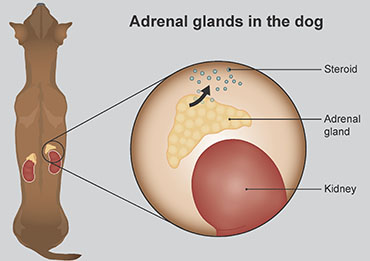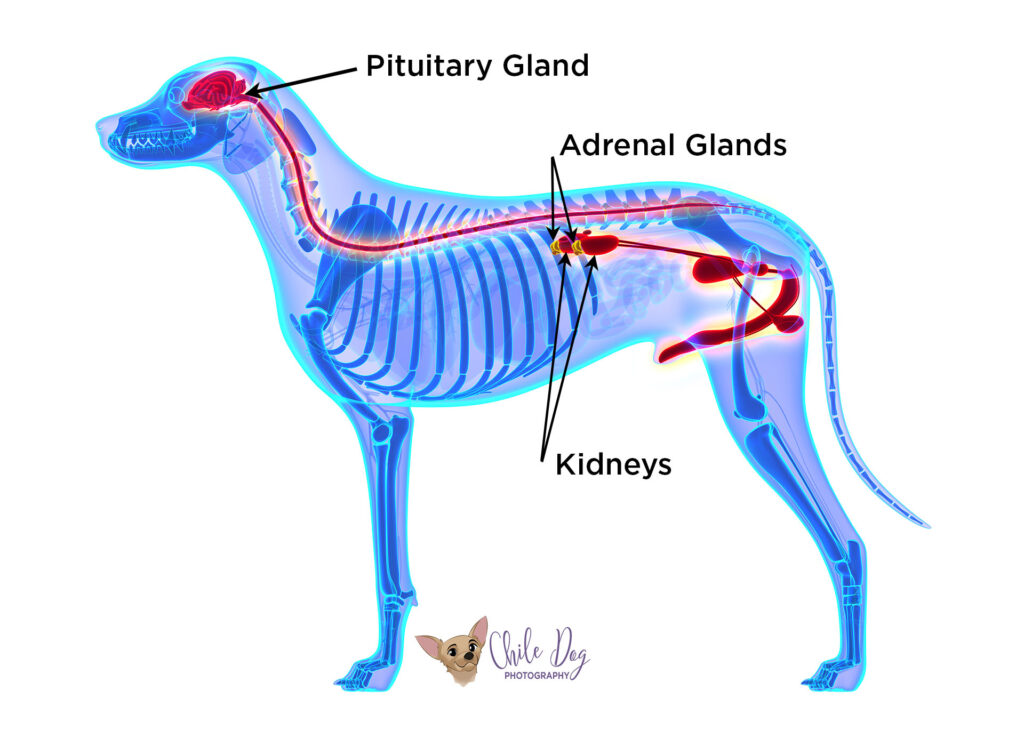
Addison’s Disease in Giant Breeds: What Every Dog Owner Needs to Know
Addison’s disease, also known as hypoadrenocorticism (HOAC), is a serious endocrine* disorder that can affect giant dog breeds. This condition arises when the adrenal glands, located near the kidneys, fail to produce adequate amounts of crucial hormones, particularly cortisol and aldosterone. These hormones are essential for regulating metabolism, maintaining sodium and potassium levels, and helping the body respond to stress. While Addison’s disease can affect all types of dogs, it is particularly notable in giant breeds and must be taken seriously. Timely diagnosis and management can allow dogs affected by Addison’s disease to live full and healthy lives.
*(tissue that makes and releases hormones that travel in the bloodstream and control the actions of other cells or organs.)
In giant breeds, Addison’s disease is somewhat rare, but its consequences can be severe if left undiagnosed. While proper breeding practices have reduced the prevalence of the disease in some breeds, it remains a potential concern, particularly in young to middle-aged adult females. Addison’s can affect dogs at any point in their lives, and dog owners should be familiar with the signs and symptoms. Early detection is key to preventing life-threatening situations, such as an Addisonian crisis, which can happen if hormone levels drop too low. Responsible breeding practices have made a significant impact, yet the threat remains present, particularly in genetically predisposed dogs.
The Great Imitator: Recognizing the Signs
One of the most challenging aspects of Addison’s disease is its ability to mimic other, less serious conditions. Often referred to as “the great imitator,” Addison’s disease can manifest with a wide range of symptoms. This can make it particularly difficult for both dog owners and veterinarians to diagnose early. Symptoms in dogs can be varied and include lethargy, muscle weakness, increased thirst, frequent urination, vomiting, diarrhea, and even hair loss. These symptoms are often vague and can come and go, making it easy to mistake them for gastrointestinal upset, stress, or other minor health issues.
Lethargy is one of the most common early signs, with affected dogs often appearing unusually tired or less interested in their usual activities. Muscle weakness may follow, causing dogs to tire quickly after exercise or struggle with movements that were once easy for them. Gastrointestinal symptoms, such as vomiting, diarrhea, and a lack of appetite, are also common. As these symptoms often resemble those of other conditions, they can easily be overlooked, delaying diagnosis. Increased thirst and urination can be mistakenly attributed to issues like urinary tract infections or kidney problems, further complicating the diagnosis.
Symptoms:
- Lethargy
- Muscle weakness
- Vomiting and diarrhea
- Increased thirst and urination
- Hair loss
- Weight loss
- Trembling or shaking
These symptoms often fluctuate, making diagnosis challenging. If you notice any of these signs, consult your vet immediately.

One of the hallmarks of Addison’s disease is that the symptoms often appear in cycles, worsening and improving over time. These fluctuations can confuse owners, as the dog may appear healthy for weeks or months before another bout of symptoms occurs. This cyclical nature of Addison’s disease is one reason why it is often misdiagnosed or not diagnosed at all until the condition becomes critical. Dogs with undiagnosed Addison’s can suffer an Addisonian crisis, which is life-threatening and requires immediate veterinary attention.
Diagnosing Addison’s Disease: What to Expect
If you suspect that your giant breed dog may have Addison’s disease, it’s essential to seek veterinary attention promptly. Diagnosis often begins with a thorough review of the dog’s medical history, including any changes in appetite, energy levels, or behavior. Due to the non-specific nature of Addison’s disease symptoms, veterinarians rely on a series of blood tests to confirm the diagnosis.
One of the most definitive tests for diagnosing Addison’s disease is the ACTH stimulation test. ACTH (adrenocorticotropic hormone) is a naturally occurring hormone that prompts the adrenal glands to produce cortisol. In this test, a veterinarian takes a baseline blood sample to measure the dog’s cortisol levels. Then, synthetic ACTH is administered, and another blood sample is taken a short time later. In a healthy dog, cortisol levels will rise significantly after the ACTH injection. However, in a dog with Addison’s disease, there will be little to no increase in cortisol levels, confirming the diagnosis.
Blood tests may also reveal abnormal electrolyte levels, particularly elevated potassium and low sodium levels, which are telltale signs of Addison’s disease. Electrolyte imbalances can have serious consequences, such as heart arrhythmias and muscle weakness. Early detection of these imbalances can prevent further complications, but if the disease goes unnoticed, it can lead to severe illness or even death. Therefore, understanding these signs and acting swiftly is crucial for dog owners.
Managing Addison’s Disease: Treatment and Prognosis
The good news for dog owners is that, while Addison’s disease is a lifelong condition, it is manageable with the right treatment. Treatment typically involves hormone replacement therapy, which compensates for the hormones that the adrenal glands no longer produce. This often includes a combination of mineralocorticoids, such as fludrocortisone, to regulate sodium and potassium levels, and glucocorticoids, such as prednisone, to replace cortisol.
Once diagnosed, dogs with Addison’s disease can lead long, healthy lives, provided they receive consistent treatment and monitoring. Most dogs will need daily or monthly medication, depending on the type of hormone replacement prescribed by their veterinarian. Regular blood tests are also necessary to ensure that hormone levels remain stable and that the dog’s electrolytes are in balance. Adjustments to medication dosages may be required periodically, particularly during times of stress, illness, or injury, as dogs with Addison’s disease may need additional glucocorticoids during these times to help their bodies cope.
For giant breed owners, it’s important to work closely with a veterinarian experienced in treating endocrine disorders to ensure proper management of Addison’s disease. Routine vet visits, medication administration, and careful observation of symptoms can make all the difference in maintaining the dog’s quality of life. With the right care, most dogs diagnosed with Addison’s disease will thrive, continuing to enjoy their favorite activities and companionship with their families.
Home Remedies and Natural Supplements: Can They Help?
While traditional hormone replacement therapy is essential for managing Addison’s disease, some dog owners may be curious about natural or homeopathic treatments to support their dog’s overall health. It’s important to note that natural remedies should never replace prescribed medications but can be used as a supplement to conventional treatments.
Herbs like licorice root, ginseng, and ashwagandha have been used to support adrenal function and may help to manage stress in dogs with Addison’s disease. Omega-3 fatty acids, commonly found in fish oil supplements, can also promote overall health by reducing inflammation and supporting joint and heart health. Milk thistle is another commonly recommended supplement for supporting liver function, which can be beneficial for dogs undergoing long-term medication use.
A balanced, nutritious diet is also critical for dogs with Addison’s disease. Ensuring that your dog is receiving high-quality protein, healthy fats, and easily digestible carbohydrates can support overall health and help them maintain energy levels. A diet rich in essential vitamins and minerals can also bolster the immune system and aid in maintaining proper electrolyte balance. Dog owners should consult with their veterinarians before introducing any new supplements or making changes to their dog’s diet.
Preventing Addison’s Disease: Can It Be Avoided?
Unfortunately, there is no known way to prevent Addison’s disease, as it is often an inherited condition, particularly in certain breeds. However, responsible breeding practices can reduce the prevalence of the disease in susceptible breeds. Genetic testing and screening for adrenal health can be valuable tools for breeders, helping them make informed decisions when planning litters.
For dog owners, early recognition of symptoms and regular veterinary check-ups are key to managing the disease. Awareness of your dog’s breed-specific health risks and remaining vigilant for signs of adrenal insufficiency can lead to quicker diagnosis and better outcomes. While the diagnosis of Addison’s disease can feel overwhelming, it is important to remember that with proper care, most dogs can continue to live happy, healthy lives.

Conclusion: Managing Addison’s Disease with Confidence
Addison’s disease is a serious but manageable condition that can affect giant breed dogs. Early recognition, accurate diagnosis, and ongoing treatment are critical to ensuring a good quality of life for affected dogs. With hormone replacement therapy and regular monitoring, dogs with Addison’s disease can thrive and enjoy a full, active life.
Owners should be aware of the early signs, such as lethargy, vomiting, and increased thirst, and seek veterinary care if they suspect their dog may be affected. While natural remedies and lifestyle adjustments can offer additional support, they should never replace conventional medical treatments. A combination of responsible breeding, early detection, and consistent care can greatly improve the prognosis for dogs with Addison’s disease.
If you suspect your dog may have Addison’s disease or are looking for more information, consult with your veterinarian for a comprehensive evaluation. Understanding the risks and taking action early can make all the difference in managing this condition effectively.
Disclaimer: The information provided in this blog post is for educational purposes only and should not be considered medical advice. Always consult with a healthcare professional for medical concerns.
